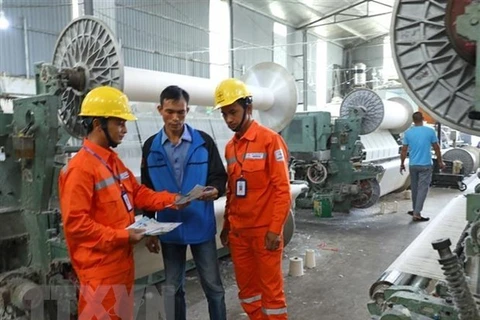 A worker of the Hanoi Power Corporation under the Vietnam Electricity group (EVN) checks an electrical facility (Photo: VNA)
A worker of the Hanoi Power Corporation under the Vietnam Electricity group (EVN) checks an electrical facility (Photo: VNA) Hanoi (VNA) - Hanoi is attempting to cut total energy consumption by 5 - 7 percent and bring electricity losses down to less than 4 percent by 2025, according to the municipal Department of Industry and Trade.
These are the targets Hanoi is aiming for under the national energy efficiency programme, which will be implemented in the capital using 130 billion VND (nearly 5.6 million USD) from the local budget.
The department said Hanoi has already taken the lead in implementing the national programme, as seen in its Earth Hour activities, its support for enterprises to improve energy efficiency to boost product competitiveness, and its promotion of power-saving efforts in transport, services, and daily activities.
To cut power losses, the city targets that, by 2025, all key transport businesses will have carried out programmes on fuel-saving driving skills for workers and applied technical solutions on saving energy in vehicle use.
It expects all companies at local industrial parks and clusters, along with 80 percent of rural industrial facilities and craft villages, to access and apply energy efficiency solutions. All major energy consumers are also expected to use standardised energy management systems.
Hanoi is also working to ensure compliance by new constructions with the national technical standards for energy efficiency in buildings, the department noted.
It added that the capital aims to have 330 establishments and constructions recognised as having “green” energy and energy efficiency by 2025, and at least two or three named “green” and energy efficient constructions at the national level each year.
In implementing the national energy efficiency programme, Hanoi is also looking to cut energy consumption by industry compared to the 2016-2020 period.
In particular, it plans to reduce the amount of energy use in textile and garment manufacturing by at least 5 percent, in the production of alcohol and other beverages by 3 - 6.88 percent, in the paper industry by 8 - 15.8 percent, in the chemical industry by at least 7 percent, and in plastics production by 18 - 22.46 percent.
Hanoi also hopes that 60 percent of local schools will step up communications regarding and teach students about energy efficiency by 2025.
The Department of Industry and Trade noted that in order to encourage local organisations, businesses, and people to use energy efficiently, since the beginning of this year authorities have worked to call for power-saving practices, participation in the Earth Hour campaign, the replacement of tungsten lamps with LED bulbs, and the installation of rooftop solar panels.
It also sent text messages with tips on saving electricity to 100,000 households with high consumption in May, when strong heat waves were recorded, and believes energy efficiency solutions need to be implemented synchronously throughout the city to generate practical outcomes.
The national energy efficiency programme aims to reduce energy use by 5 - 7 percent between 2019 and 2025 and 8 - 10 percent in the 2019 - 2030 period, or around 60 tonnes of oil equivalent (ToE).
By 2025, the programme is to cut power losses to less than 6.5 percent and reduce average energy consumption by industry compared to the 2015 - 2018 period.
It will ensure that 70 percent of industrial parks and 50 percent of industrial clusters apply solutions to use energy economically and efficiently; that all key energy users apply standardised energy management systems; and that all key transport companies provide courses to improve worker skills in operating vehicles in an energy-saving manner.
From 2006 to 2015, the national energy efficiency programme helped Vietnam save more than 15 ToEs of energy and cut total energy consumption nationwide by 3.4 percent and 5.65 percent, respectively, in 2006 - 2010 and 2011 - 2015. The country has saved more than 9 billion kWh of electricity on average each year, equivalent to 15 trillion VND./.
VNA
























